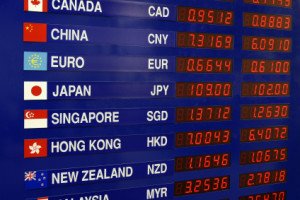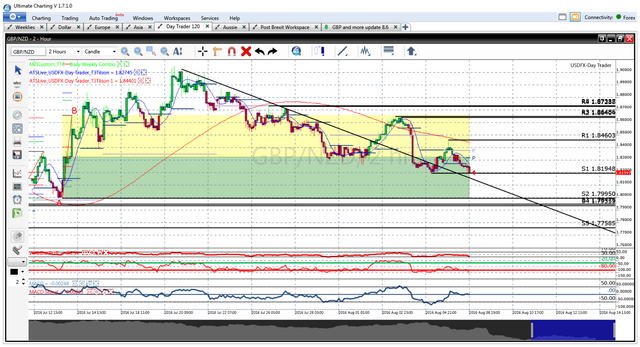Trading the Forex Market - Part 1
What is the Forex Market, anyway?
Forex, which stands for Foreign Exchange, and is also known as the spot market, is an exchange which trades one foreign currency against another. It operates 24 hours a day, 5 days a week, and trades trillions of dollars each day. This dwarfs all other exchanges by a wide margin. It is open to anyone who wants to trade it with a minimum investment of US$50.00, though you'd probably do better if you have at least 10 times that amount available. Otherwise, you will be subject to quick depletion of your account if your first couple of trades go against you.
In this market, you trade one currency against another, so you always talk of trading a pair, such as the GBPUSD, which is the Great British Pound against the US Dollar. If you have ever gone overseas, or had the need to exchange your dollars (or other base currency) for any other country's currency, you might be familiar with Exchange Shops, routinely found at airports, which provide this service to you. If so, you'll also have seen their price boards which list all the currencies they trade, each with a Sell price and a Buy price:

This is very similar to what we do on the Forex when we are trading, except that we are trading what is known as a standard lot, which is the equivalent of US$100,000 in currency. Thanks to something called margin, you do not need US$100,000 in your account. Your typical margin will be 50:1, which means that you will be required to put up just US$2,000 in order to trade a standard lot. You can also trade a minilot, equivalent to US$10,000, that would require US$200 to trade, or even a microlot, equivalent to US$1,000, and requiring only US$20 to trade.
And what we are trying to capture, is something called a pip (price interest point). If you look at the picture above with the exchange rates, you'll see that they use 4 positions after the decimal point (except for the Yen, which uses 2). Instead of saying that a Euro is worth US$0.66, the rate is set at US$0.6644. In that example, the '44' are the pips. Each pip is 1/100th of a cent. 100 pips equals 1 cent. The one exception we need to worry about is the Japanese Yen, whose base rate is in Yen. In that case, a pip is equal to 1 Japanese cent, which explains why you only see 2 digits after the decimal point. This is a key concept, since that is what you are trying to capture, pips!
When trading a full standard lot, each pip I gain represents a profit of US$10. If I lose a pip, then I lose US$10. So assuming that I bought the GBPUSD (the British Pound against the US Dollar) at a rate of US$1.2987 and the trade went in my favor and I sold it back (got out of the trade) at a rate of US$1.3107, then I made 120 pips, which at US$10/pip is a net profit of US$1,200 on a standard lot. A movement of 120 pips can happen very easily in a matter of hours, sometimes minutes. It represents a change of slightly more than 1 cent in the exchange rate. If you have ever tracked exchange rates, you know that is practically nothing in terms of regular fluctuations.
To summarize the above trade, I used US$2,000 of my capital and made US$1,200 profit with it in, say, 40 minutes. That is a 60% profit in less than an hour. If you traded a minilot, you would have made US$120 profit while using US$200 of capital. And if trading a microlot, US$12 profit while using US$20 of capital. Same 60% profit, though, in all 3 cases.
But wait! Couldn't I have lost 120 pips if the trade went against me by the same amount, leading to a loss of 60% on one trade in less than an hour? Potentially, yes. But we use other techniques such as Stops, Trailing Stops, and Limits (which we will cover in a later post) to protect us from heavy losses and to exit profitable trades. We also use Technical and Fundamental Analysis so we only enter trades where we have a higher probability of winning. Way too much to cover in one post, but I will give you a sneak peek at the current chart of the GBPNZD (British Pound against New Zealand Dollar) which I have been trading since yesterday and am currently up (profitable) by about 200 pips. That's in 1 day. And I have already protected 150 pips of that profit, so my worst case scenario is that I have banked US$1,500 of profit on this trade. If I get out now, I could get out with US$2,000 profit. But I am reasonably sure that it will drop further, and make me far more than that, maybe even 700 pips' worth of profit. The chart also shows some of the tools, known as indicators, that I use to time my entries and exits, as well as gauge the direction of the market. You can make money regardless of whether a pair is going up or down, since you can buy it (go long) or sell it (go short). If you buy it, you are trading on the expectation of it going up. If you sell it, as I did in the current GBPNZD trade, then you expect it to drop, which is precisely what it is doing.

That's it for now. Please post your comments, especially if you have any questions on what I've written above, or any suggestions for future posts. I am really looking forward to sharing all this, since it is one of the simplest ways of legally making money that I have discovered. It also involves no buying, making or building any products or services, going out to find clients or hoping they come in the door, dealing with vendors or suppliers, managing inventory, hiring people, renting an office, or any of the other activities a regular business requires. And, though it might look and seem daunting, it really isn't. Once you learn a few rules, it becomes fairly straightforward and repeatable. Just let me continue to show you how...
Excellent explanation of something that's befuddled me for years. You've got a gift for taking a complicated concept and putting it into plain language. Looking forward to more on this.
I still remember when I was new to this, and the hurdles I faced while learning. I am really glad you think I am doing a good job of explaining it. It can be hard to tell when you're writing it, how much of it is getting across crystal clear, as opposed to how much seems clear just because you, the writer, are familiar with the subject. Thank you again for your feedback, and let me know at any time if you feel something wasn't clear, or any questions you have.
Thanks..knew about Forex but definitely learned some new things
I have been at this for years, and have been very successful at it. And I still learn new things every day! If anyone ever tells you that they are the ultimate anything, and know everything there is to know about something, run. Run as fast as you can. We are all eternal students...
I am still confused ;(
Can you elaborate on precisely what is confusing you? I'll then be happy to go deeper on whatever the topic is.